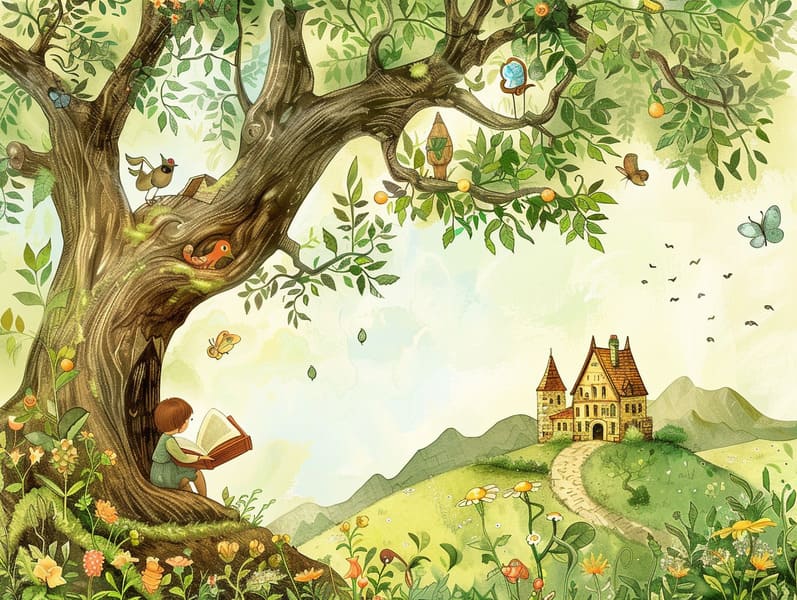
Famous fairy tales have enduring presence. These narratives have been shared from one generation to the next centuries before they were ever written down. They originated from a variety of backgrounds, including Middle Eastern traditions. They were initially narrated among grown-ups, often carrying themes and messages reflective of the societal norms and beliefs of the time.
The Grimm brothers, Jacob and Wilhelm (the Grimm brothers), were among the first to compile many of these beloved fairy tales. Their compilation, "Grimm's Fairy Tales," included tales like "Ashenputtel," "The Story of Hansel and Gretel," and "Little Snow White," which have since become pillars in the world of children's fairy tales. Similarly, the Danish author's delightful stories, such as "The Mermaid," and "The Little Duckling," have gained the love worldwide, ensuring their place in the pantheon of famous fairy tales.
Despite their age, these stories remain as applicable as ever, especially as bedtime stories for kids. These charming stories are now available in multiple formats, including artistically illustrated books, fantastical animations, and web-based fairy tales.
Their enduring popularity can be traced to several charming aspects:
Vital Lessons: Ancient fairy tales often impart important moral lessons. Tales like "The Story of the Boy Who Cried Wolf" teach the benefit of integrity, while "The Tale of the Tortoise and the Hare" emphasize the traits of tenacity and modesty. These tales offer young ones clear distinctions between moral and immoral, developing their moral compass in a kind yet meaningful way.
Warmth and Understanding: Old fairy tales frequently showcase beings facing trials and tribulations, inspiring listeners to relate with their struggles and applaud their triumphs. For instance, "Beauty and the Beast" illustrates the benefit of looking deeper to recognize the real character of a individual, fostering tenderness and understanding.
Cultural Insights: Many classic fairy tales are rich in the cultural contexts from which they developed. Discovering these tales can provide intriguing perspectives into different customs, promoting a sense of global understanding and appreciation.
Inventiveness and Fantasy: The supernatural elements in fairy tales—spells and potions—provoke children’s creativity. These tales guide readers to fantasy realms, firing up imaginative ideas and a sense of curiosity that continues a lifetime.
Ancient fairy tales are not only captivating but also illuminating. They work as bewitching tools in strengthening various brain and heart skills in the young. When old fairy tales are voiced, they develop speech development by introducing new language items and detailed sentence structures. This practice also nurtures auditory perception and mindfulness, as children hang on every word, enthusiastic to see what happens next.
Furthermore, reflecting on the themes and characters of fairy tales can nurture reasoning skills and intellectual skills. Little ones more info are guided to identify patterns, anticipate outcomes, and realize cause and effect. These discussions also boost kids verbalize their thoughts and feelings, fostering their emotional intelligence.
In today’s cyber age, the presence of web-based fairy tales has made these tales more obtainable than ever. Digital sites and programs share extensive collections of Grimm's fairy tales that can be read or listened on anytime, anywhere. Fairy tales told out loud are particularly prevalent, sharing an immersive method for children to relish these spellbinding stories. Voice books and read-to-me videos carry characters and settings to life, often accompanied by spellbinding background sounds and musical scores that enhance the tale experience.
The timeless appeal of ancient fairy tales lies in their ability to shift to new eras while holding onto their core values. Contemporary revisions of these fairy tales often showcase more varied figures and modern settings, making them understandable to today’s audience. However, the central morals of fearlessness, understanding, and integrity remain unchanged, continuing to resonate with children of all ages.
Fairy tales also offer a sense of coziness and homeliness. They deliver up a systematic narrative with a distinct beginning, middle, and end, often finishing with the closure of conflicts and the triumph of goodness over badness. This reliability can be relieving for little ones, presenting a sense of sturdiness in an unpredictable world.
Classic fairy tales continue to bewitch and guide new generations, maintaining their beauty and meaningfulness in modern society. As nighttime stories for kids, they put forth a perfect blend of magic and knowledge, fostering moral values, empathy, and creativity. The presence of online fairy tales and the popularity of fairy tales recited secure that these old stories remain acquirable to new generations.
By holding onto and communicating these tales, we continue to esteem the rich tapestry of creativity and cultural heritage. Whether you are browsing a vividly illustrated book, enjoying a online collection, or listening through an voice book, the attraction of famous fairy tales is always within reach. These narratives emphasize of the timeless strength of storytelling and its ability to bind us across eras and regions.
Regardless if you are reading a beautifully illustrated book, viewing a cyber collection, or listening via an voice book, the fascination of timeless fairy tales is always within reach.
These stories point out of the unceasing strength of fairy tales and its ability to hold us together across time and space, forging a link that delights and instructs alike.